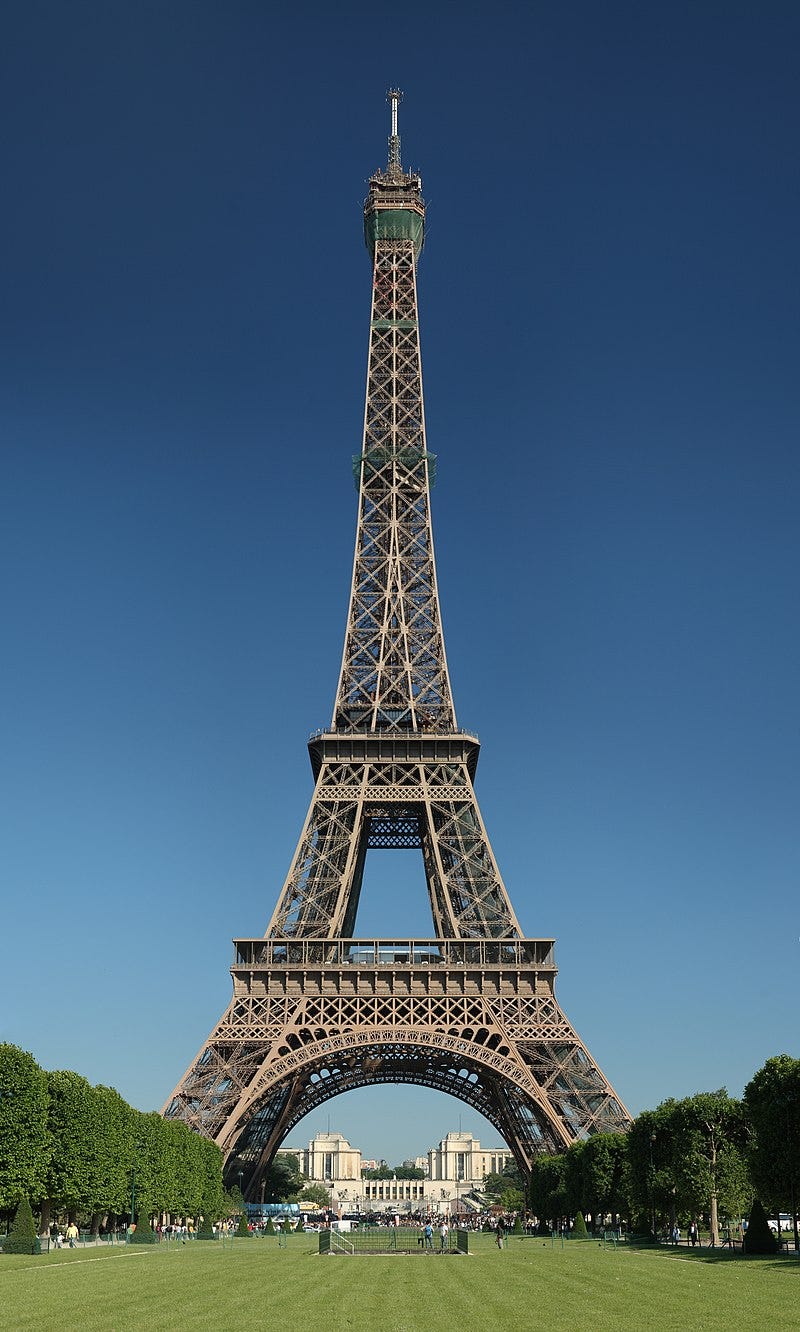“The Eiffel Tower, which even money-grubbing America, we can be certain, would not want, is the dishonour of Paris. Everyone knows that, everyone says it, and everyone is profoundly upset – and we are only the weak echo of the universal public opinion, which is rightly alarmed. One has only to imagine a vertiginously ridiculous tower dominating Paris like a gigantic black factory chimney, crushing by its barbouress massiveness Notre-Dame, the Saint-Chappelle, the Saint-Jacques tower, the Louvre, the dome of the Invalides, the Arc de Triomphe etc.
The public petition from which this passage is taken was signed in 1887 by a starry cast of around fifty intellectuals including writers Alexander Dumas, Leconte de Lisle and Guy de Maupassant, architect Charles Garnier, composers Gounod and Massanet, playwright Victoria Sardou and numerous architects. These avowed ‘passionate lovers of beauty’ put themselves forward as representatives of all who loved historic Paris yet despised the thought that it should be desecrated by the ‘the odious shadow of this hollowed-out column of sheet metal’ on which building was just starting.
For a construction which was so comprehensively condemned by a substantial part of the literary and artistic intelligentsia before a single one of the 2.5 million rivets it would require had been hammered into place, the Eiffel tower has worn astonishingly well”.[1]
Reading this passage recently as I work my way through a book on the ‘biography’ of Paris reminded me of the disciple Thomas, who has our attention today.
Those French luminaries doubted the Eiffel Tower before it was even built; more than that, they despised it. They had in their mind something that would be utterly disruptive to the Paris that they knew and loved, or perhaps, more, that they imagined.
In John’s gospel reading before us, Thomas, often called a doubter, wants to be sure of the material reality of the resurrected Christ. Here, at least as far as we can tell, he was in part unique among some of the others who had encountered the resurrected Christ who took their first encounters with him as sufficient that all had changed. Thomas though wanted more: “Unless I see the nail marks in his hands and put my finger where the nails were, and put my hand into his side, I will not believe”.
Thomas not only wanted to see Jesus; he wanted to see the scars of Jesus, the proof that this living, breathing, resurrected Jesus was one and the same as the Jesus who was crucified, and not some apparition.
It’s not immediate, but a week later, that Thomas gets that opportunity, meets Jesus, receives the invitation to “see my hands; reach out your hand” and proclaims, ‘My Lord and My God”. We never know, by the way, whether Thomas did touch the scars of Jesus, or whether it was enough to see it. But, regardless, that intimate encounter was enough for that proclamation and Jesus’ invitation to “stop doubting and believe”.
The thing is not all who saw believed, and not all who didn’t see believed either. Jesus’ encounter with Thomas here is about Thomas here. Thomas was hardly the first or only to doubt Jesus’ resurrection. Most of the other disciples did too, at least initially, when the women returned from the empty tomb to tell them Jesus was risen.
Indeed, the presence of the risen Jesus doesn’t necessarily clarify, or remove doubt. It shifts the question from ‘something has happened’ to ‘what exactly has happened’?[2] There was an existing widespread belief at the time in a general resurrection, so the question would have been, why Jesus, and why now?
Thomas’ doubt, then, may be more than just about the fact of the resurrection – but its effect. If the risen Jesus bore the scars of crucifixion – where his body was mortally wounded but not broken - then that means death itself no longer had any power.
This, therefore, was not just one example of some general resurrection, but something particular about this Jesus – his identity, his materiality, his physicality, his triumph, even, over the last enemy, death itself. And if death can be vanquished, what else is there? All that Thomas had witnessed and seen and heard as he travelled as one of Jesus’ disciples may have started to find a new shape, to make sense in new ways, to see that even where doubt exists (as it does) so does belief.
None of us now can imagine Paris without the Eiffel Tower, which is as strong a case against those distinguished naysayers as you could find. And none of us could imagine a faith without a risen Christ at its centre. Because as most who go to Paris want to be able to see the Eiffel Tower, so most, even in the midst of the most profound doubts that befall us all, want to see the risen Christ. In that way Thomas is us. Not the doubters and the detractors who then and now say that there’s nothing about this Jesus that we should bother. But those who doubt and yet even in that doubt see belief, as we too are invited to reach out our hands, to open our eyes, and to proclaim the risen Jesus, amongst us, bringing life, making all things new.
Let me pray.
Christ our light,
like Thomas we need to see,
need to touch,
need to be sure before we believe.
When we don't know, help us to trust;
when we can't see, help us to keep on walking.
Praise to you our God; you answer prayer.[3]
[1] Colin Jones, Paris: Biography of a City, Penguin Books, 2004, p.391
[2] Thomas and the Body of Jesus - by Andrew McGowan
[3] For All the Saints, p.434




